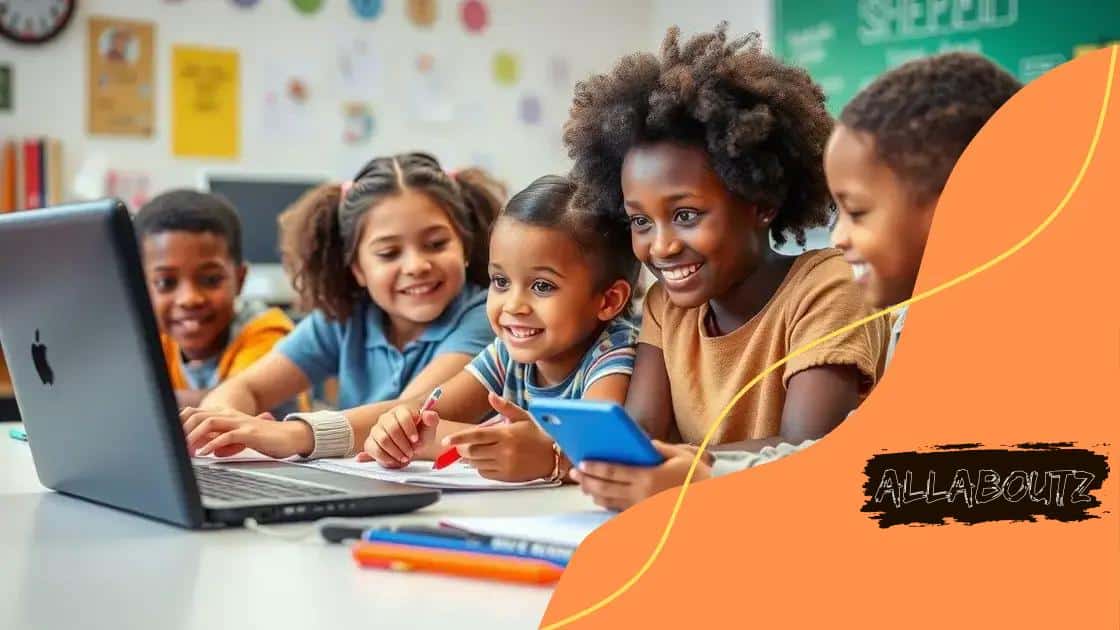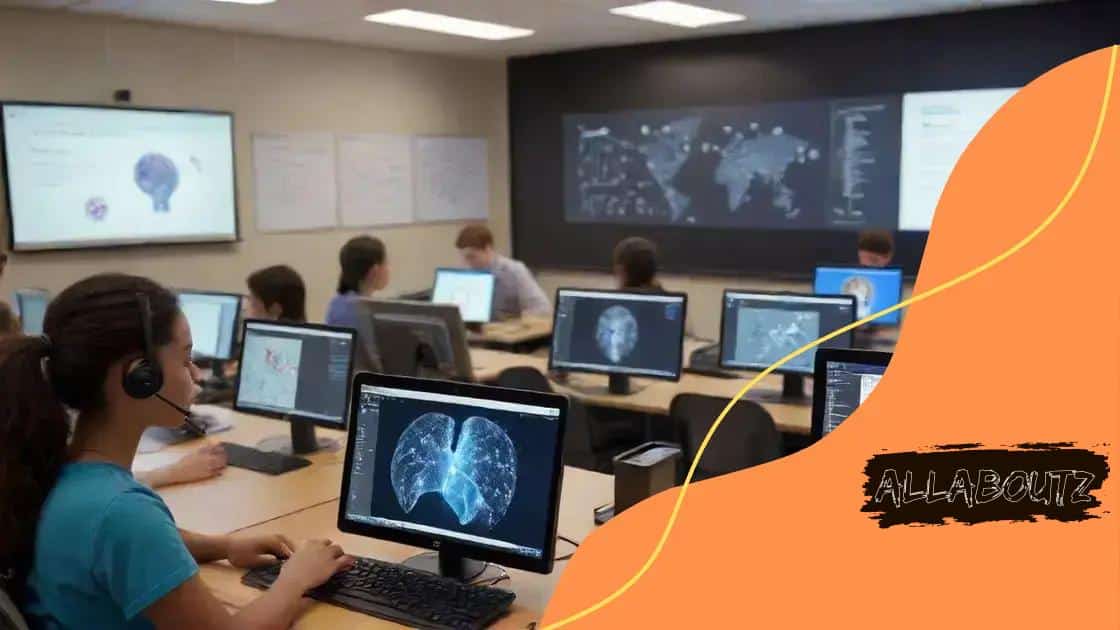AI-assisted tools for special education classrooms

AI-assisted tools for special education classrooms enhance personalized learning, improve student engagement, and provide vital support for educators by adapting to individual learning needs and fostering an inclusive environment.
Have you considered how AI-assisted tools for special education classrooms can enhance learning outcomes for students with diverse needs? These innovative resources are designed to support both educators and learners, making a real impact in the classroom.
Understanding AI-assisted tools in special education
Understanding AI-assisted tools in special education is vital for improving learning experiences for students with unique needs. These tools help educators tailor their approaches and offer personalized support. By utilizing technology, we can foster an environment where every student can thrive.
What are AI-assisted tools?
AI-assisted tools are software and resources that leverage artificial intelligence to support the educational process. They analyze data to provide feedback and suggestions that are beneficial for both teachers and students. With these tools, lessons can be adapted in real-time to meet individual requirements.
Benefits of AI-assisted tools
- Enhanced engagement through interactive learning experiences.
- Individualized instruction tailored to student’s learning pace.
- Rich data analysis to track student progress effectively.
- Support for diverse learning styles and challenges.
Moreover, these tools can streamline administrative tasks, allowing teachers to focus more on instruction. For instance, AI technology can assist in grading and providing feedback, freeing up time for educators to engage more deeply with their students.
One significant advantage is that AI-assisted tools can identify early signs of learning difficulties, allowing for timely interventions. By analyzing patterns in student performance, teachers can determine where a child may need additional support, ensuring that no learner gets left behind.
As technology advances, these tools will likely become even more sophisticated, offering greater capabilities for customization. It’s important for educators to stay informed and explore how various technologies can be integrated into their classrooms.
In summary, embracing AI-assisted tools in special education not only enhances the learning experience for students but also empowers educators to be more effective in their roles. Staying aware of the benefits and possibilities can lead to more successful educational outcomes for all.
Benefits of AI tools for special needs students
The benefits of AI tools for special needs students are profound and varied. These tools provide tailored learning experiences that cater to individual strengths and weaknesses. By personalizing education, we can help every student achieve their potential.
Individualized Learning Experiences
One significant advantage is that AI tools can create individualized learning paths. They assess student performance and adapt lessons accordingly. This personalization ensures that each child receives the right level of challenge and support, making learning more effective.
Improved Engagement
AI tools often incorporate engaging, interactive elements that can captivate students’ attention. When learning becomes fun, students with special needs are more likely to participate actively. Engaged learners are more likely to persist through challenges.
- Interactive software that makes learning enjoyable.
- Visual aids and gamified content to spark interest.
- Feedback features that encourage student persistence.
Moreover, through targeted feedback, students can instantly see their progress. This immediate response not only motivates them to continue improving but also builds self-esteem.
Collaboration among peers is another area where AI tools shine. They enable students to work together on projects or exercises, fostering social skills. When students collaborate, they learn not only academic content but also how to communicate and problem-solve together.
Enhanced Monitoring and Assessment
AI tools can also enhance tracking of student progress. Teachers can receive valuable insights into how each student is performing. This data allows educators to make informed decisions about interventions when needed.
Overall, the integration of AI tools in special education classrooms creates a supportive environment that promotes learning. By addressing the unique needs of each student, we can significantly improve educational outcomes.
Examples of AI tools used in classrooms

There are numerous examples of AI tools used in classrooms that are revolutionizing education. These tools enhance the learning experience by providing personalized support and engaging activities for students. Let’s explore some of these innovative resources.
AI-Powered Learning Platforms
Many educational organizations have developed platforms that adapt to students’ learning styles. For instance, tools like DreamBox Learning and Khan Academy use AI to analyze a student’s progress and suggest tailored exercises to improve their skills. This personalized approach makes each learning path unique.
Speech Recognition Software
Another excellent example is speech recognition tools, such as Google Read & Write. These programs help students, especially those with speech or language impairments, by converting spoken words into text. This functionality allows students to express their thoughts more easily and access their learning materials.
- Interactive Tutorials: Programs like CodeCombat teach coding through engaging gameplay, making learning programming fun.
- Assessment Tools: AI tools like Formative provide instant feedback to both students and teachers, enhancing the educational process.
- Reading Assistance: Tools like Texthelp support students in understanding complex texts through readability adjustments.
Additionally, AI-powered virtual assistants such as Sophia can answer student queries in real time, bridging gaps in information. This feature allows teachers to focus on providing more individualized support to students who may need it.
Moreover, utilizing data analytics, platforms can alert teachers to any learning difficulties their students might be facing. This proactive approach helps in adopting timely interventions, ensuring that all learners receive the necessary support.
The integration of AI tools in educational settings is not just about enhancing the teaching experience; it’s about making learning accessible and enjoyable for everyone. As technology continues to evolve, these tools will only become more sophisticated, paving the way for even greater educational advancements.
Implementation strategies for educators
When it comes to the implementation strategies for educators using AI-assisted tools, a thoughtful approach is essential. These strategies can help ensure that both teachers and students benefit from the technology available.
Start with Training
One effective strategy is to provide thorough training for educators. Understanding the capabilities and features of AI tools will empower teachers to utilize them effectively. Professional development workshops can help educators feel confident and prepared to integrate technology into their classrooms.
Set Clear Goals
Establishing clear objectives for using AI tools is also crucial. Educators should define what they aim to achieve, such as improving student engagement or personalizing learning experiences. Having specific goals in mind allows for focused implementation and easier assessment of outcomes.
- Define needed student outcomes.
- Align AI tool features with curriculum goals.
- Incorporate feedback mechanisms to assess effectiveness.
Another important element is fostering a culture of collaboration among educators. Sharing experiences and best practices can help teachers learn from one another. This collaborative environment promotes the sharing of resources and strategies, accelerating the learning curve for everyone involved.
Monitoring and adjusting the implementation process is key as well. Educators should regularly evaluate how well AI tools are working in their classrooms. Gathering feedback from students can provide insights into what works and what needs improvement. This continuous cycle of feedback and adjustment helps optimize the learning experience.
Engage Students Actively
Engaging students actively in their learning process is essential when implementing AI tools. Educators should encourage students to explore and utilize these technologies independently. Creating opportunities for students to give feedback on their experiences with the tools can lead to improvements and make them feel valued in the process.
By investing in education and involving students in the process, educators can greatly enhance the impact of AI tools in special education. These implementation strategies work together to create a positive learning environment where students can thrive.
Future trends in AI for special education
Future trends in AI for special education are exciting and promising. As technology evolves, these advancements are set to transform how we approach learning for students with unique needs.
Personalized Learning Experiences
One significant trend is the continued focus on personalized learning experiences. AI technologies are becoming increasingly sophisticated, enabling them to adapt in real-time to a student’s individual learning style and pace. This means that students will receive tailored guidance that meets their specific needs, thereby enhancing their educational outcomes.
Integration of Virtual Reality (VR)
Virtual reality is another emerging trend in education. By creating immersive learning environments, VR can make difficult concepts more accessible for special needs students. These engaging experiences can significantly boost motivation and retention of information.
- Interactive simulations that replicate real-life scenarios.
- Safe spaces for students to practice skills without judgment.
- Enhanced focus on task completion in unique environments.
Moreover, the use of AI to analyze data will improve assessment methods. Educators will have access to advanced analytics that track student progress comprehensively. This data-driven approach will help identify patterns and areas where students are excelling or struggling, facilitating timely interventions.
Collaboration Tools
Collaboration tools powered by AI will also enhance teamwork among students. By enabling real-time communication and feedback, these tools can foster peer interactions, encouraging students to work together on projects. Authentic collaboration will help build essential social skills, important for both academic and personal development.
As AI continues to advance, it will also drive the development of more assistive technologies. These tools will further empower students with disabilities, providing them with greater independence and access to educational resources. With ongoing improvements in natural language processing and speech recognition, students will have enhanced means to communicate, learn, and express themselves.
In summary, the future of AI in special education looks bright. By focusing on personalized learning, utilizing innovative technologies like VR, and enhancing collaboration, educators will be better equipped to support their students’ diverse needs.
FAQ – Frequently Asked Questions about AI-assisted Tools in Special Education
What are AI-assisted tools?
AI-assisted tools are technologies that use artificial intelligence to provide personalized learning experiences and support for students, particularly those with special needs.
How do these tools benefit educators?
These tools enable educators to tailor lessons, track student progress effectively, and identify individual learning challenges, enhancing the overall teaching experience.
Can AI tools help with student engagement?
Yes, many AI tools incorporate interactive elements that make lessons more engaging, fostering a more active learning environment for students.
What trends are emerging in AI for special education?
Emerging trends include personalized learning experiences, virtual reality integration, and enhanced collaboration tools that support social skills among students.





